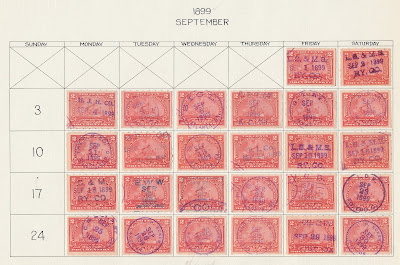This is the
second of three posts on the 2 cent documentary battleship calendar in which all 36 months of the calendar will be posted. This post involves the second year of primary use of these stamps, from July 1899 to June 1900. The calendar is nearly complete with cancels from all dates during the 12 month period except for most Sundays and July 4.
The calendar is replete with cancels from railroads and companies that maintained their own rolling stock.
July includes cancels from the following companies:
July 1: Lake Shore and Michigan Southern Railway
July 3: Ann Arbor Railroad
July 5: Canadian Pacific Railway
July 10: Cornplanter Refining Company
July 11: Southern Pacific Railroad
July 12: Michigan Southern Railroad
July 17: Elgin, Joliet & Eastern Railway
July 19: Chicago, Indianapolis & Louisville Railway
July 22: New York Central & Hudson River Railroad
July 24: Merchants Despatch Transportation Company
July 25: Northern Ohio Railway
July 26: Fairmount Coal & Coke
July 27: Chicago, Milwaukee & St. Paul Railway
July 28: Cleveland, Canton & Southern Railway
July 31: Keokuk & Western Railroad
As I noted in a post about this calendar in April 2009, I originally obtained this calendar in an auction of Henry Tolman's collection by Robert Siegel. The calendar was sold in as a single lot near the end of Part 4 of the Siegel Tolman sales. As I wrote in that earlier post, it is not clear to me that this calendar was compiled by Mr. Tolman. Margin notes in Tolman's hand that spell out the identification of certain cancels read like the notes of someone who is reviewing a calendar after it has been completed by another and not the notes of someone that had spent 100s if not thousands of hours putting together such a calendar.
Just as Robert Bell marvelled at Keightly's completion of the Penny Lilac calendar for the quality of handstamp cancels, this calendar should create similar marvel. Most cancels are clear, and while there is much repetition of one railroad (the LS&MS), there is striking variety of railroads and large industrial companies.
Cancels from the Cleveland oil refiner Scofield, Shurmer & Teagle (Oct 4), the Central Equipment Company (Oct 17), and The American Cereal Company appear on the October 1899 page of the calendar amid a field of railroad cancels. All of these companies likely had their railroad cars for the products: tankers for SS&T and hoppers for The American Cereal Company.
In some cases the cancels range to shipping companies, including the Detroit & Cleveland Navigation Company, whose handstamp cancel can be found in the November 18 slot.
In the next few days I will post the final year of this calendar, from July 1, 1900 to June 30, 1901. As of July 1901 taxes were ended on bank checks and drafts, ending the primary use for the 2 cent documentary stamp. The original compiler of this calendar did not go beyond June 30, 1901. 2 cent documentaries can be found in mixed usage into 1902 for purposes other than checks and drafts.




























































